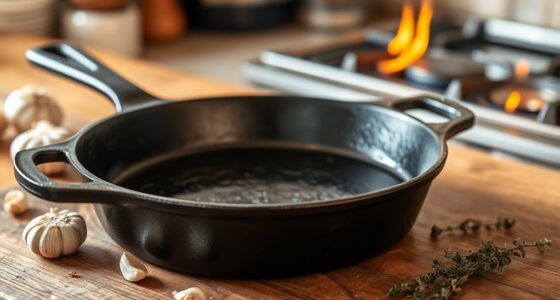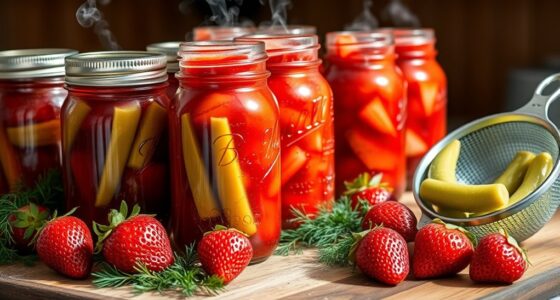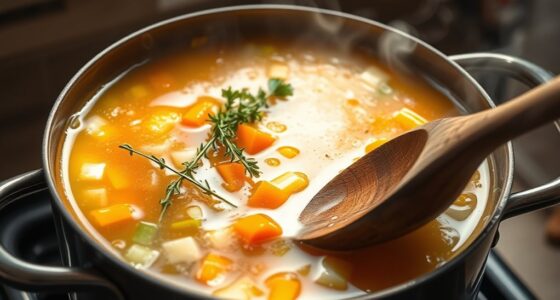To make quick pan sauces, start by removing your cooked meat or vegetables and keep the flavorful bits (fond) in the pan. Pour in a liquid like wine, broth, or water to deglaze, scraping up those tasty bits. Let it simmer until slightly reduced, then add aromatics, herbs, or a splash of acid for balance. Finish with butter or cream for richness. Continue exploring, and you’ll master how to turn simple pan drippings into delicious sauces every time.
Key Takeaways
- Deglazing involves adding liquid to a hot pan to loosen flavorful browned bits (fond).
- Use wine, broth, or water to deglaze, scraping up the bits to create a flavorful base.
- Incorporate aromatics and acidity to balance and enhance the sauce’s flavor profile.
- Reduce the sauce by simmering to concentrate flavors and achieve desired consistency.
- Finish with butter or cream for richness, adjusting seasoning to perfect the taste.

Ever wonder how to elevate a simple dinner into a restaurant-quality meal? The secret often lies in creating a rich, flavorful pan sauce that ties everything together. Making these sauces might seem intimidating, but once you understand the basics—like deglazing and flavor balancing—you’ll see it’s straightforward and rewarding. The key is to start with well-chosen ingredient pairings. After cooking your protein, such as chicken, steak, or fish, you’ll notice flavorful bits stuck to the pan, called fond. These bits are packed with concentrated flavor and are the foundation for your sauce. Deglazing involves adding a liquid—like wine, broth, or even water—to the hot pan to loosen these flavorful bits. As you scrape the bottom with a spoon or spatula, you release their essence, creating a flavorful base. This step alone transforms a simple pan drippings into a rich, aromatic foundation.
Once you’ve deglazed, it’s all about balancing flavors. Adding ingredients like aromatics—garlic, shallots, or herbs—enhances complexity. You might then incorporate a splash of acid, such as lemon juice or vinegar, to cut through richness and brighten the sauce. To achieve flavor harmony, taste as you go, adjusting with salt, pepper, or a touch of sweetness if needed. For example, a splash of honey or a pinch of sugar can soften sharp acidity or bitterness, creating a more rounded profile. Remember, ingredient pairings matter: pairing red wine with beef, white wine with chicken or fish, and broth with vegetables ensures your sauce complements the main dish perfectly.
Thickening your sauce is the final step. You can reduce it by simmering to concentrate flavors or add a small amount of butter or cream for richness and velvety texture. Stirring in these ingredients at the end ensures the sauce remains smooth and flavorful. The goal is to craft a sauce that not only enhances the dish but also balances all the flavors—salty, sweet, sour, and umami—so nothing overwhelms. With practice, you’ll learn how different ingredients interact, creating a symphony of flavors that elevate your cooking. Mastering deglazing and flavor balancing turns a simple pan drippings into a luxurious, restaurant-quality sauce—adding sophistication and depth to any meal.
Frequently Asked Questions
Can I Make Pan Sauces Without Alcohol?
Yes, you can make pan sauces without alcohol. Use alcohol-free alternatives like broth, apple cider vinegar, or grape juice to deglaze the pan. These options still provide flavor enhancement, giving your sauce depth without alcohol. Simply add your chosen substitute after cooking your protein, scrape up the browned bits, and simmer until the sauce thickens. This way, you get a delicious, flavorful sauce suitable for all preferences.
How Do I Prevent Sauce From Becoming Too Salty?
You can prevent your sauce from becoming too salty by focusing on salt balancing and flavor enhancement. Start by tasting as you cook and add salt gradually. If it gets too salty, stir in a splash of water, broth, or a touch of acid like lemon juice to neutralize the excess. Incorporate ingredients like cream or sugar to balance the flavor, ensuring your sauce remains rich without overpowering saltiness.
What Are Alternative Liquids to Wine or Broth?
If you want alternative liquids to wine or broth, try using flavor enhancers like soy sauce, fish sauce, or Worcestershire sauce for depth. You can also use liquid substitutes such as apple juice, coconut milk, or even tomato juice to add moisture and flavor. These options are versatile and can adapt to various dishes, giving you a quick way to create rich, flavorful sauces without relying on traditional wine or broth.
How Do I Store Leftover Pan Sauces Safely?
To store leftover pan sauces safely, transfer them to an airtight container and refrigerate within two hours of cooking. Use proper storage tips by labeling the container with the date. When you’re ready to enjoy, reheat the sauce on the stove over low heat, stirring occasionally, or in the microwave in short bursts. Always check for freshness before serving, and discard if it smells off or shows signs of spoilage.
Can I Use Non-Stick Pans for Making Pan Sauces?
Yes, you can use non-stick pans for making pan sauces, but keep in mind their limitations. Non-stick surfaces don’t develop the fond needed for deep flavor, so your sauce might lack richness. To enhance flavor, try adding aromatics like garlic or shallots early and deglazing with wine or broth. Just avoid high heat, as non-stick coatings can degrade. Use non-stick pans for convenience but supplement with flavor techniques for best results.
Conclusion
Now that you know how to deglaze and craft quick pan sauces, you’re ready to transform simple leftovers into flavorful masterpieces. Imagine a sizzling skillet, the rich aroma swirling as the sauce coats your dish like a silky ribbon. It’s the contrast between humble pan drippings and vibrant flavors that elevates your cooking. With these techniques, everyday ingredients become a canvas, turning a basic meal into a stunning, restaurant-worthy plate in just minutes.









